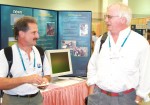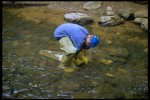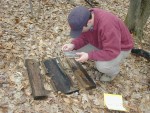When he inherited the network of 80-odd independent research and monitoring sites in 1998, Hague Vaughan, Director of the Ecological Monitoring and Assessment Network (EMAN) Coordinating Office at Environment Canada, realized immediately that his primary tasks would be to better integrate efforts across jurisdictions, agencies and disciplines, to extend partnerships beyond the Network, and to "make the science it produces work better within the society it’s intended to serve."
Within these overarching goals, Hague sees his tasks as very specific: standardizing monitoring among existing programs so as to make data and information comparable and delivering the results to decision makers as feedback so as to allow policies, programs and development to be adaptive and responsive to environmental changes.
"The bad thing about monitoring is it takes a long time to do, even longer to produce intelligible results, and much longer than that to get the information to the policy makers and the public," Hague reflects. "Monitoring and research are all very important and we all know this, but it’s in the translation and transmission of results that the process usually breaks down.
"At EMAN we don’t dictate to anybody what will be done, but we do deliver the findings."
At the recent Ecological Society of America annual meeting in Tucson Arizona, Vaughan and EMAN Science Advisor Brian Craig attended as many symposia and oral sessions as humanly possible. "We’re here to steal ideas," Hague says.
In the sessions, many scientists speak in terms of ‘making the information available,’ "But for EMAN,"Vaughan says, " we must deliver it. We must continuously demonstrate the relevance of ecological monitoring and related research to management and the public. We’ve seen funding cuts to research and monitoring programs occur left and right because no one knows why the work is important!"
EMAN’s modus operandi exclusively involves partnerships. Among those partners are the people -- municipalities and neighborhoods of Canada.
| What is EMAN? |
|
The Ecological Monitoring and Assessment Network (EMAN) is a cooperative partnership of federal, provincial and municipal governments, academic institutions, aboriginal communities and organizations, industry, environmental non-government organizations, volunteer community groups, elementary and secondary schools and other groups/individuals involved in ecological monitoring in Canada to better detect, describe, and report on ecosystem changes. EMAN was established in 1994 with the following four objectives:
|
Brian Craig manages the outreach program called NatureWatch. "We are creating tool kits of equipment and instructions for communities to use to monitor the environment in their own neighborhoods. We get standardized data which provides early indications of change and the community gets sound information on whether the local environment is being degraded" Craig, who is also the data manager for this project, says the data, as well as continued outreach efforts, are valuable for management. "It’s totally win-win. That’s how we do it. We need and value that data and well as the community input."
Despite the hard work and commitment required for NatureWatch, the community has much to gain from the exercise. "Basically it’s empowerment," Vaughan says. "Our land-use decisions are usually made at the local level. By involving them directly in monitoring the ecological processes that are going on in their own neighborhoods, communities can make educated and experience-based decisions about their own futures." Vaughan emphasizes that community involvement is very democratizing.
"There is no dominance by any single organization -- not even Environment Canada (the government agency), because the partners become autonomous through their knowledge. EMAN partners are engaged because they get more out of it than they put in, otherwise they wouldn’t stay with us. We only work in areas of shared interest: command and control is not an issue.
"We take the monitoring data produced by some partners and synthesize it; push preliminary risk-based information toward policy, government and individuals contributing what’s needed to make programs, decisions and behaviours adaptive. With partners who run established research or monitoring programs, we merge at the information level -- rarely at the data level. So in this way it’s different than LTER. But we share much of the same spirit and the same science. It’s just that we tend to focus on enhancing the effectiveness of ecological monitoring, on products and outcomes" Like LTER, standardization in data collection and management are important ongoing issues. "But we try to motivate by promising to send the message both ways -- if the collection end is standard, it’s easier to make a convincing argument to policy makers to bring about real change."
| What is NatureWatch? |
|
The Ecological Monitoring and Assessment Network (EMAN), in partnership with the Canadian Nature Federation (formerly the Canadian Audubon Society), has established a series of NatureWatch programs to collect reliable information and contribute to local, regional and national monitoring programs. NatureWatch protocols are designed by scientific experts for validity and reliability, and are available for use by people regardless of their monitoring experience. Through NatureWatch, monitoring project managers can expand the capacity of local monitoring information collection by engaging the broader community. Learn more about EMAN and NatureWatch on the Web site. |
In Canada, much research is done outside of universities so policy makers have a larger say in government research priorities and funding In comparison to the US. They have less independence between science and policy. The Environment Canada mandate includes interjurisdictional waters, transboundary issues, species at risk, migrating birds, indigenous lands, ice, and water. But its higher order objectives involve creating a society where people make responsible informed decisions about sustainability and the environment and that to Hague means that Environment Canada needs partnerships to cooperate in delivering solid integrated information on changes, choices and possible trade-offs. "Our projects must prove beneficial to everyone involved and must deliver timely, relevant, useful and accessible information to suit the specific needs of the decision process" Vaughan calls it ‘demand-driven science.’
Most of Vaughan’s efforts go into forming partnerships with other organizations, including NGOs and community groups. "The net effects are to make the environmental groups more scientific, and the ecosystem monitoring more relevant to the community," Vaughan says. "You must offer timely feedback on monitoring and research to managers, to funders, and to the community. We try to make clear the links to policy, so everyone knows what’s going on and can in turn offer feedback. All of this demonstrates the relevance of ecological monitoring information and brings a greater appreciation of, and security to, our science agency partners" In turn Vaughan says these community players readily buy into the EMAN concept because it meets their needs, offering them a network of support, access to information, and avenues to policy making.
EMAN uses a suite of commonly understood indicators for early detection of ecosystem change, which were adopted upon consulting with a large cadre of advisors, including the USFS. "But still we operate at the community level, including indigenous people (called "First Nations" in Canada). This way we’re not perceived as a threat. We don’t tell people what to monitor, we just help them do it. And we ensure the results reach the constituents."
Vaughan believes the environmentalists can be tremendous allies. "We give [environmental, non-governemental organizations] tools to foster scientifically sound decisions so they can move back from confrontation and toward partnerships." Among the closest partners is the Canadian Nature Federation (CNF-formerly the Canadian Audubon Society). "The birders are now looking at habitat, invasives, connectivity and landscapes as well as wielding scientific language in their arguments," Vaughan says. "It’s all about decision-making, consequence and human relationships."
The study of the relationships between humans and their environment is a life-long interest for Vaughan who studied the Ecology of the Mayan Empire for his PhD. at the University of Florida.
"In my Maya work, I established that the minimal unit of study was that within which society, economics, culture, climate and environment are intimately interacting components. The trajectory was of an ecosystem moving through time and if you tried to study a part in isolation, say cultural change or vegetational change, you couldn’t make sense of it because there were inevitably pieces missing. When we make decisions today based on only economic or social or even only environmental factors, they will always be incorrect to some degree which in many cases will be very great indeed."

 Enlarge this image
Enlarge this image

